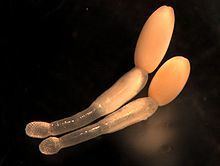Rank Genus | ||
 | ||
Similar | ||
Profilicollis is a genus of acanthocephalan parasites of crustaceans. The status of the genus Profilicollis has been debated, and species placed in this genus were formerly included in the genus Polymorphus. However, research on the morphology of the group and their use of hosts has concluded that Profilicollis and Polymorphus should be regarded as distinct genera, and species previously described as Polymorphus altmani are now referred to as Profilicollis altmani in the literature. Profilicollis parasites infect decapod crustaceans, usually shore crabs, as intermediate hosts, and use many species of shorebirds as definitive hosts.
Contents
Life cycle
Profilicollis altmani is a species of acanthocephalan parasite, also described as Profilicollis kenti and Profilicollis texensis, although the status of this parasite is not fully resolved. This parasite first develops in the haemocoel of Emerita spp. mole crabs, in North and South America. After infection of the mole crab (the intermediate host), the parasite becomes a dormant cystacanth until the crab is eaten by a suitable bird, such as the surf scoter Melanitta perspicillata or herring gull, Larus argentatus (the final or definitive host). Once the parasite cystacanth has passed through the stomach of the bird, it develops into the adult worm and attaches to the intestines of the bird. Eggs produced by the parasite are released from the bird with bird feces and enter the ocean. Here the eggs are transported by the currents until they are accidentally ingested by a filter-feeding mole crab. Interestingly, Profilicollis altmani has become the subject of increasing research as it has been discovered that this parasite is contributing to a substantial proportion of the deaths of the southern sea otter, Enhydra lutris nereis. Between 1998 and 2001, between 13% and 16.2% of sea otter carcasses found around central California the cause of death was determined to be a direct result of acanthocephalan peritonitis, caused by this species of parasite. Several decades ago, the proportion of sea otters dying because of these parasites was almost negligible. Most of the sea otters that were found to be killed by infections by Profilicollis altmani were either young juvenile or older female otters, and it is hypothesized that they feed on sand crabs because they are less skilled at foraging or because of a decrease in their preferred prey.
Species and hosts
Behavioral manipulation
Like many other acanthocephalans, recent studies have shown that the presence of cystacanth of Profilicollis antarcticus causes behavioral alterations due to changes in the levels of hemolymph dopamine in its intermediate host, the crab Hemigrapsus crenulatus. These changes in the biogenic amino levels can cause behavioral changes such as changes in response to external stimuli resulting from neurological damages (escape behavior), increased conspicuity resulting from modified pigmentation and/ or behavior and castration. Previous studies have also shown that crabs infected with cystacanths exhibit higher metabolic rates and activity levels than non-parasitized crabs.
The free living conditions of cystacanths in the hemocoelomic cavity of the intermediate host maybe interpreted as the direct way of altering the dopamine metabolic pathway.The alteration of dopamine levels in the hemolymph system implies that there is a generalized effect of the parasite on the body of its intermediate host, rather than an effect on the nerve ganglion level. Therefore, the increase in activity and metabolic rates for this host parasite system could be a consequence of higher metabolic cost of maintenance for the host, linked to the synthesis of monoamines and/ or the physiological consequences of their bio-availability. This altered physiological condition is beneficial for the parasite,considering that their final goal is to increase transmission by increasing the probability of predation on the intermediate host(the crab)by its definitive host(the gull).
